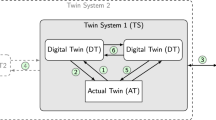Abstract
Digital twins have the potential to revolutionize the way we design, build and maintain complex systems. They are high-fidelity representations of physical assets in the digital space and thus allow advanced simulations to further optimize the behaviour of the physical twin in the real world. This topic has received a lot of attention in recent years. However, there is still a lack of a well-defined and sufficiently generic data structure for representing data-driven digital twins in the digital space. Indeed, the development of digital twins is often limited to particular use cases. This research proposes a data structure for developing modular digital twins that maintain the coherence between the digital and physical twins. The data structure is based on a hierarchical representation of the digital twin and its components; the proposed data structure uses concepts from distributed systems and object-oriented programming to enable the integration of data from multiple sources. This enables the development of a digital twin instance of the system and facilitates maintaining the coherence between the digital twin and the physical twin. We demonstrate the effectiveness of our approach through a case study involving the digital twin of an industrial robot arm. Our results show that the proposed data structure enables the efficient development of modular digital twins that maintain a high degree of coherence with the physical system.
This work has been supported by the French ANR PRC grant COHERENCE4D (ANR-20-CE10-0002).
Access this chapter
Tax calculation will be finalised at checkout
Purchases are for personal use only
Similar content being viewed by others
References
Grieves, M.: Digital twin: manufacturing excellence through virtual factory replication, March 2015
Grieves, M., Vickers, J.: Digital twin: mitigating unpredictable, undesirable emergent behavior in complex systems. In: Kahlen, F.-J., Flumerfelt, S., Alves, A. (eds.) Transdisciplinary Perspectives on Complex Systems, pp. 85–113. Springer, Cham (2017). https://doi.org/10.1007/978-3-319-38756-7_4
Autiosalo, J., et al.: A feature-based framework for structuring industrial digital twins. IEEE Access 8, 1193–1208 (2020)
Hribernik, K., et al.: Autonomous, context-aware, adaptive Digital Twins State of the art and roadmap. Comput. Ind. 133, 103508 (2021)
Fan, Y., et al.: A digital-twin visualized architecture for Flexible Manufacturing System. J. Manuf. Syst. 60, 176–201 (2021)
Yi, L., et al.: Process monitoring of economic and environmental performance of a material extrusion printer using an augmented reality-based digital twin. Addit. Manuf. 48, 102388 (2021)
Fang, L., Liu, Q., Zhang, D.: A digital twin-oriented lightweight approach for 3d assemblies. Machines 9, 231 (2021)
Gopalakrishnan, S., et al.: Integrating materials model-based definitions into design, manufacturing, and sustainment: a digital twin demonstration of incorporating residual stresses in the lifecycle analysis of a turbine disk. J. Comput. Inf. Sci. Eng. 21(2), 021006 (2020)
Luo, W., et al.: Digital twin for CNC machine tool: modeling and using strategy. J. Ambient. Intell. Humaniz. Comput. 10, 1129–1140 (2019)
Fonseca, I.A., et al.: A standards-based digital twin of an experiment with a scale model ship. Comput. Aided Des. 145, 103191 (2022)
Jiang, H., et al.: How to model and implement connections between physical and virtual models for digital twin application. J. Manuf. Syst. 58, 36–51 (2020)
Zhidchenko, V., Startcev, E., Handroos, H.: Reference architecture for running computationally intensive physics-based digital twins of heavy equipment in a heterogeneous execution environment. IEEE Access 10, 54164–5418 (2022)
Cai, Y., et al.: Using augmented reality to build digital twin for reconfigurable additive manufacturing system. J. Manuf. Syst. 56, 598–604 (2020)
Schroeder, G., et al.: Digital twin data modeling with AutomationML and a communication methodology for data exchange. IFACPapersOnLine 49, 12–17 (2016)
Liu, C., et al.: Web-based digital twin modelling and remote control of cyber-physical production systems. Robot. Comput.-Integr. Manuf. 64, 101956 (2020)
Jones, D., et al.: Characterising the digital twin: a systematic literature review. CIRP J. Manuf. Sci. Technol. 29, 36–52 (2020)
Baptista, L.F., Barata, J.: Piloting Industry 4.0 in SMEs with RAMI 4.0: an enterprise architecture approach. Procedia Comput. Sci. 192, 2826–2835 (2021)
Abdel-Aty, T.A., et al.: Asset administration shell in manufactuing: applications and relationship with digital twins. IFAC PapersIbkube 55–10, 2533–2538 (2022)
Node-Red Homepage. https://nodered.org/. Accessed 31 Jan 2023
RoboDK Homepage. https://robodk.com/. Accessed 31 Jan 2023
Author information
Authors and Affiliations
Corresponding author
Editor information
Editors and Affiliations
Rights and permissions
Copyright information
© 2024 IFIP International Federation for Information Processing
About this paper
Cite this paper
Orukele, O., Polette, A., Gonzalez Lorenzo, A., Mari, JL., Pernot, JP. (2024). A Data Structure for Developing Data-Driven Digital Twins. In: Danjou, C., Harik, R., Nyffenegger, F., Rivest, L., Bouras, A. (eds) Product Lifecycle Management. Leveraging Digital Twins, Circular Economy, and Knowledge Management for Sustainable Innovation. PLM 2023. IFIP Advances in Information and Communication Technology, vol 701. Springer, Cham. https://doi.org/10.1007/978-3-031-62578-7_3
Download citation
DOI: https://doi.org/10.1007/978-3-031-62578-7_3
Published:
Publisher Name: Springer, Cham
Print ISBN: 978-3-031-62577-0
Online ISBN: 978-3-031-62578-7
eBook Packages: Computer ScienceComputer Science (R0)





